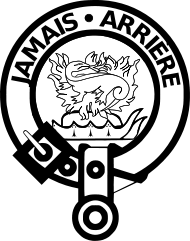
Back Clan Douglas German Clan Douglas Spanish Douglas Estonian Douglas (suku) Finnish Clan Douglas French שבט דאגלס HE Clan Douglas Italian Škotijos klanai Lithuanian Klan Douglasów Polish Дугласы Russian
| Douglas | |||
|---|---|---|---|
| Dùbhghlas[1] | |||
 Crest: On a chapeau, a green salamander surrounded by fire | |||
| Motto |
| ||
| Slogan | "A Douglas! A Douglas!" | ||
| Profile | |||
| Region | Lowlands | ||
| District | Lanarkshire,[1] Lothian, Scottish Marches, Angus,[1] Moray, Galloway[1] and Dumfriesshire[1] | ||
| Plant badge | Rue | ||
| Pipe music | Dumbarton's Drums | ||
 | |||
| Douglas no longer has a chief, and is an armigerous clan | |||
| Historic seat | Douglas Castle[2] | ||
| Last Chief | His Grace Archibald Douglas The 1st Duke of Douglas | ||
| Died | 21 July 1761[b] | ||
| |||
| |||
| |||
| |||
Clan Douglas (Gaelic: Dùbhghlas) is an ancient clan or noble house from the Scottish Lowlands.
Taking their name from Douglas in Lanarkshire, their leaders gained vast territories throughout the Borders, Angus, Lothian, Moray, and also in France and Sweden. The family is one of the most ennobled in the United Kingdom and has held numerous titles.
The Douglases were one of Scotland's most powerful families,[4] and certainly the most prominent family in lowland Scotland during the Late Middle Ages, often holding the real power behind the throne of the Stewart kings.[citation needed] The heads of the House of Douglas held the titles of the Earl of Douglas (Black Douglas) and later the Earl of Angus (Red Douglas).[5] The clan does not currently have a chief recognised by the Lord Lyon. The principal Douglas today is the Duke of Hamilton, but as his surname is "Douglas-Hamilton" rather than simply "Douglas" the laws of the Lyon Court prevent him from assuming the chiefship of the name.
The original caput of the family was Douglas Castle in Lanarkshire. The Kirk of St Bride at Douglas, along with Melrose Abbey and the Abbey of Saint-Germain-des-Prés holds the remains of many of the Earls of Douglas and Angus.[6]
The Swedish branch is descended from Field Marshal Robert Douglas, Count of Skenninge, and has been one of Sweden's most prominent noble families since the 17th century.[7][8]
- ^ a b c d e f Clan Douglas Profile scotclans.com. Retrieved 13 April 2014.
- ^ Coventry, Martin. (2008). Castles of the Clans: The Strongholds and Seats of 750 Scottish Families and Clans. pp. 150–159. ISBN 978-1-899874-36-1.
- ^ a b c d e f g h i j k l m Scots Kith & Kin. HarperCollins. 2014. p. 58. ISBN 9780007551798.
- ^ Way, George and Squire, Romily. (1994). Collins Scottish Clan & Family Encyclopedia. (Foreword by The Rt Hon. The Earl of Elgin KT, Convenor, The Standing Council of Scottish Chiefs). pp. 384–385.
- ^ Cite error: The named reference
JimHewitsonwas invoked but never defined (see the help page). - ^ Lynch, Michael, ed. (2011). Oxford Companion to Scottish History. Oxford University Press. pp. 172–176. ISBN 978-0-19-923482-0.
- ^ Alexia Grosjean, "A century of Scottish Governorship in the Swedish Empire, 1574–1700", in A. Mackillop and Steve Murdoch, Military Governors and Imperial Frontiers, 1600–1800: A Study of Scotland and Empires (Brill, Leiden, 2003), pp. 53–78.
- ^ "Grevliga ätten Douglas, No 19", in Sveriges ridderskaps och adels kalender 2013, Riddarhuset, 2013
Cite error: There are <ref group=lower-alpha> tags or {{efn}} templates on this page, but the references will not show without a {{reflist|group=lower-alpha}} template or {{notelist}} template (see the help page).
© MMXXIII Rich X Search. We shall prevail. All rights reserved. Rich X Search